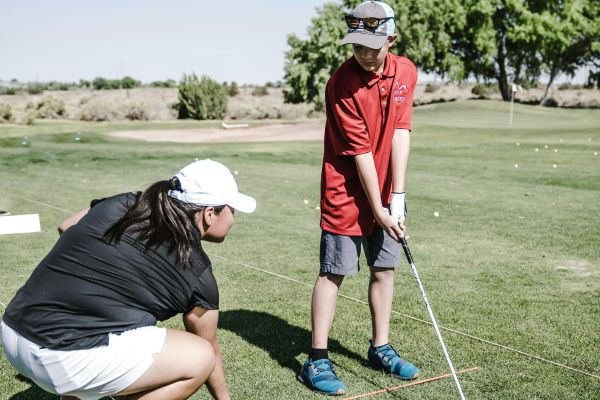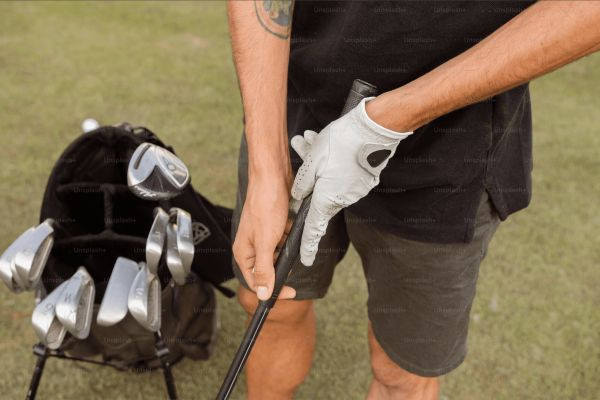A Guide to Strategic Golf Chipping
Have you ever watched in awe as pros like Tiger Woods or Phil Mickelson masterfully chip the ball close to the pin, making what's arguably one of the game's most challenging aspects look like a walk i..

Have you ever watched in awe as pros like Tiger Woods or Phil Mickelson masterfully chip the ball close to the pin, making what's arguably one of the game's most challenging aspects look like a walk in the park? You're not alone.
Chipping, a seemingly simple shot, is a make-or-break skill that significantly impacts your scoring. But what if I told you that with a bit of strategy, practice and understanding, you could chip your way to a better scorecard?
Why Chipping is Crucial
The importance of chipping is not just about moving the golf ball from one place to another; it's about aiming, distance and control. New or experienced golf players have to know chipping as well and if you haven't understood this skill, getting to this level can change your overall game, from saving a stroke to saving a hole.
When it comes to an 18-hole round, on average, a golfer will have faced between 36 and 40 chip shots. That's a lot of different scoring opportunities and if you have struggled in this essential area of the game, it may lead to more than a few wasted chances. In fact, most golfers have difficulties around the green and especially when they have yet to learn the short game, they're four to five shots away from seeing lower scores.
Fundamentals of Chipping
Club Selection: Finding the Right Tool for the Shot
Loft is known to be how high and how far the golf ball is going to fly. A higher loft, like that of a lob wedge, is what launches the ball into a steep ascent and decline, perfect for clearing an obstacle or stopping a ball quickly on the green. The bounce is going to be the part of the club that is hitting the ground. A club that has more bounce is going to be less likely to dig into the turf that you are hitting from, which makes it beautiful for a soft ground or the sand.
At times when the green is lower you would want to choose a lower lofted club with a shallower angle of attack that will allow for a long effortless run with a 7 iron. When finesse is required you might choose a higher lofted club like the lob wedge that will allow for the ball to be hit high and when it makes contact with the green will be able to stop right away.
Perfecting Your Chipping Technique
When chipping it's crucial to find the balance in how you hold the club. You want a grip that's secure enough to guide your shot but gentle to allow for wrist movement. Think of it like holding a bird – firm enough to keep it safe yet gentle enough not to harm it. Your stance should be slightly narrower than usual when taking a shot with the ball placed closer to your foot. This setup encourages a downward strike, which is key for controlling the ball's trajectory.
The chipping motion involves making a swing similar to the club moving back and forth in a controlled manner. Let your shoulders lead this motion to ensure that your hands are ahead of the clubhead at impact. This technique is vital for achieving precise contact with the ball sending it off on its intended path.
Developing Distance Control
To hone your ability to judge distances accurately, consistent practice is key. Set up targets at distances and experiment with using clubs for chipping. Observe how each club affects both the flight and roll of the ball. This drill not only hones your precision, in distance control but also boosts your knack for selecting the club for each scenario.
Mastering the art of gauging distances is a blend of instinct and skill. With time you'll refine your swing's length and pace based on the shot at hand. This adjustment is subtle. Stems from a grasp of your abilities and how the ball behaves upon landing.
Overcoming Common Chipping Challenges
Managing Varied Course Conditions
The course is ever evolving; it changes with the weather, time of day and season. Tailoring your chipping approach to these conditions is crucial for maintaining consistency and confidence in your gameplay.
Adapting to Rough Grass: When chipping from such terrain a modified strategy is needed. Opt for a club, with loft to lift the ball while ensuring a grip to prevent it from getting snagged in the grass. Practice chipping from various lengths to gauge the force required to reach the green.
Navigating Uphill and Downhill Lies: When you're on an incline or decline the position of the ball in your stance can significantly affect the outcome of your chip shots. For uphill lies, place the ball a bit forward in your stance to strike it upward solidly. On downhill lies do the opposite by positioning the ball further back and focusing on a controlled swing to avoid overshooting.
Bunker Shots: Dealing with bunker shots can be daunting for golfers of any level. The key is using the technique and club, a sand wedge to lift the ball out of the sand. Practice hitting the sand rather than solely aiming for the ball to leverage the bunkers resistance for lofting.
Troubleshooting Common Mistakes
Even seasoned golfers face missteps now and then. Recognizing and fixing mistakes can transform chips into satisfying victories.
Avoiding Thin and Fat Shots: A thin shot glides across the green while a fat shot burrows into the ground before making contact with the ball. Both can be minimized by keeping your weight and maintaining a swing rhythm. Make sure to keep your head down and concentrate on hitting the ground below the ball.
Correcting Overactive Hands: Relying much on wrist movement can cause error in chipping. To fix this focus on moving your arms and shoulders without use of your wrists. You can use drills that emphasize controlling your shoulders to get used to this motion.
Practicing Chipping Drills and Exercises
Dedicated practice is crucial, for getting better at golf especially when it comes to chipping where accuracy and control are key.
The Ladder Drill for Distance Control: This exercise involves chipping balls to targets that are progressively farther away, similar to climbing a ladder. It helps you learn how to adjust the distance by choosing the right club and adjusting your swing strength. Start with targets. Work your way up gradually to improve your control.
Alignment Stick Accuracy Drill: Using alignment sticks or clubs on the ground can give you feedback on how you're aiming your chips. Practice by chipping along the line of the sticks and try to land the ball as close as possible to your target line.
Regular, Focused Practice: The secret to mastering chipping is practice.
Practice consistently in various situations. Embrace difficult lies to improve your chipping skills over time. This will help you develop muscle memory and confidence, turning your chipping into an asset for your game.
Crafting a Strategic Chipping Game Plan
Analyzing the Green and Surroundings
Before gripping your club carefully observe the area ahead of you. Factors like the greens slope, pin placement and any potential hazards are essential for making decisions. Ask yourself:
- Is the green sloping or flat?
- Are there bunkers or water hazards to consider?
- What is the condition of the grass?
This assessment is akin to scouting before a mission providing details for sound decision making.
Selecting the Appropriate Shot Based on the Situation
Each chip shot's unique so your strategy should be adaptable. When selecting your shot think about:
- Distance to the Pin: How far do you need the ball to travel in the air and how much roll do you need after landing?
- Ground Conditions: Is the ground firm, requiring a bounce or soft, necessitating a more lofted shot to stop quickly?
- Club Confidence: Are you more comfortable with a high lofted wedge or a lower iron for a bump-and-run?
Conclusion
Ultimately, chipping is a skill that truly takes a lot of practice and patience to perfect. Knowing when and when not to use a chip, what technique to use and how to encourage yourself into making a good power shot, not a halfhearted one, are all key factors in a great chipping game. If you are able to achieve the perfect power chip in any situation, you are going to find that other golfers are going to want you on their team.
Frequently Asked Questions (FAQs)
What is the best club to use for chipping around the greens?
It would depend on a lot of things. Typically, Wedges in general are popular clubs for chips because of their versatility in loft. However, the 7, 8 and 9- irons can also be a good choice for chipping because you want the ball to have more roll and less loft if you find yourself too far from the hole to pitch the ball.
How can I avoid chunking the ball when chipping?
First off you should make sure and try to get a downward strike on the ball which will also help you make consistent contact. One thing a lot of people don’t do during their chip shot is get their weight slightly shifted forward which is very important if you want to hit the ball clean. This will also help you stay down as you swing and avoid any fat shots. Most fat shots occur because the player does not transfer weight properly to the left side on the downswing.
What's the key to controlling distance in chipping?
Mastering distance control requires a combination of the right club selection, consistent swing tempo and regular practice to develop a sense of feel for different shots.
Is it better to chip with a high lofted club or a lower lofted club?
The answer is, it all depends on the situation. If you need to stop your chip shot quickly and with very little roll it’s better to use a high lofted club. If you need your chip shot to run more then it stays in the air then a lower lofted club is better.








































































